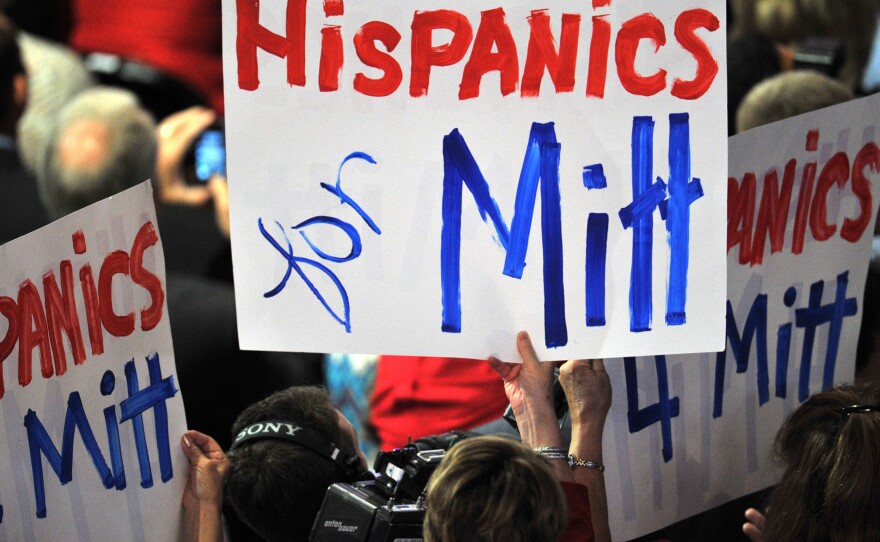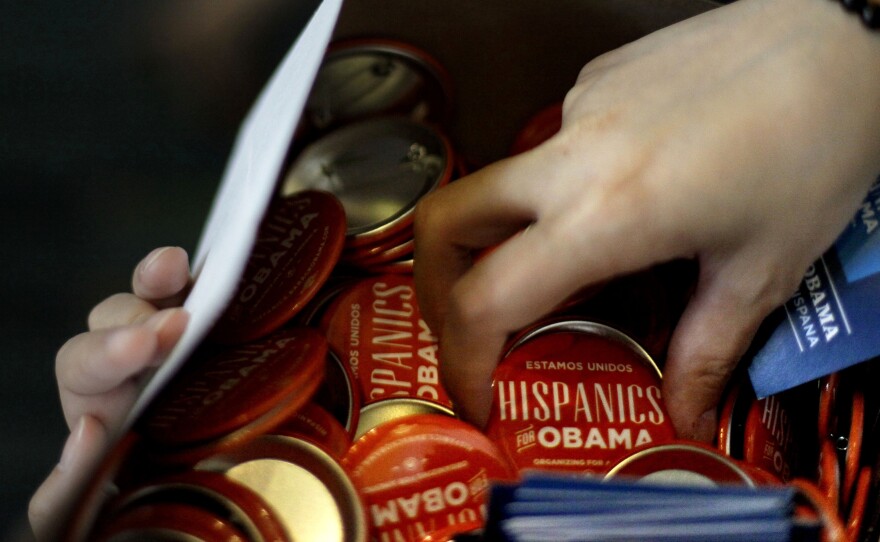In this year's presidential election, more than 1 out of every 10 eligible voters is Hispanic, and the group's political clout is growing.
In Florida and other states, more Hispanics have already registered to vote this year than in 2008, and the presidential campaigns have spent $11 million on Spanish-language political ads — eight times the amount spent in the previous election.
But that represents a small fraction of total campaign spending, and it's confined to just a handful of states, according to an analysis by the ad tracking firm Kantar Media CMAG.
The report, prepared for NPR and PBS NewsHour, found that through September, the presidential campaigns had run Spanish-language ads in just seven media markets.
Kantar's Ken Goldstein says that information provides a window into the thinking of the campaigns of President Obama and Republican nominee Mitt Romney.

"Advertising is reality ... [and] advertising is the ultimate tell," Goldstein says. "Campaigns can say they're targeting a particular population, but it's really the case [that] if they're not doing it in paid advertising, they're not doing it."
Targeted Communities
Half of the spending targeted at Hispanics came in just three cities: Miami, Orlando and Tampa. Those, of course, are in Florida, the largest swing state, where nearly 1 out of every 6 voters is Hispanic.
Most of the rest of the spending is focused on two other battleground states where Hispanics are key: Nevada and Colorado.
Javier Palomarez of the U.S. Hispanic Chamber of Commerce thinks the campaigns are selling Latinos short. Even in Florida, Palomarez says Spanish-language ad spending is far less than what it should be.
"It's a prime target that the political campaigns simply have not figured out yet," Palomarez says. "The audience for Spanish-language media is most certainly a voting audience, and it deserves the attention of our political candidates."
If spending is the measure, the Obama campaign has worked harder to reach Hispanics in these key markets, spending double what the Romney campaign has allocated for Spanish-language ads.
Matt Barreto is an associate professor of political science at the University of Washington who helps direct polling at Latino Decisions. The group's most recent tracking poll shows Romney capturing just over 23 percent of the Latino vote, although his numbers are slightly higher in battleground states.
Barreto says that is less than the 31 percent of the Hispanic vote Republican John McCain received four years ago, and far below the goal of 38 percent the Romney campaign has set.
"They need to really increase that outreach and make a connection," Barreto says. "They need to make a sincere and solid connection with Latino voters, so they can get back up to 30, 35 [or] 40 percent of the Latino vote."
Since the end of August, the Romney campaign has stepped up its spending on Spanish-language ads, but Barreto believes the Romney campaign is still learning how to best reach Hispanics in their native language.
The campaign's largest ad buy features an English-speaking Romney with Spanish subtitles. That might be a good way to introduce the candidate, but it's just a start. Barreto says the campaign also has to speak to the issues Latinos care about in their own language.
Barreto is most critical of the first Spanish-language ad put out by the campaign, called Day One, a direct Spanish translation of an English-language Romney ad. In it, Romney promises to repeal President Obama's health care overhaul.
"This [the health care law] is something very popular and very highly supported in the Latino community," Barreto says. "That shows their inability to communicate and understand this electorate. So, they need to do their homework."
Obama's Edge
In reaching Hispanics, the Obama campaign has an advantage: The campaign already did it successfully in 2008, when more than two-thirds of Latinos voted for the president. And as they did four years ago, analysts say Obama's Spanish-language ads connect with Hispanics in style as well as substance.
Cristina Saralegui, known as the "Hispanic Oprah," is featured in several Obama ads. Another series profiles Obama campaign volunteers who talk about why they support the president.
One ad, filmed in the Tampa area, shows volunteer Elena Vidal McCullough meeting with a Latino couple to talk about the president's health care overhaul.
Barreto believes that these kinds of ads — using real people — help build trust with Hispanic voters.
"There's lots of images of people within the Latino community there talking about ... [the] achievements Obama is trying to sell," he says. "They come across as much more authentic."
As the election approaches, the Romney campaign says it is planning a last-month ad blitz aimed at winning over Hispanics. In a new ad released Tuesday, it says Obama is saddling the next generation with a $16 trillion debt.
The Romney campaign and the GOP are counting on concern about the economy to mobilize voters. But in the meantime, they're still figuring out how to speak to Latinos.
Copyright 2022 NPR. To see more, visit https://www.npr.org. 9(MDAzMjM2NDYzMDEyMzc1Njk5NjAxNzY3OQ001))







